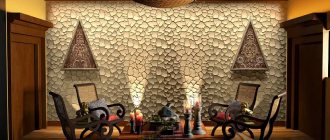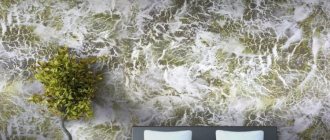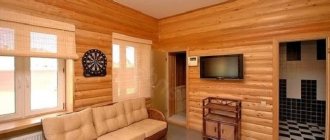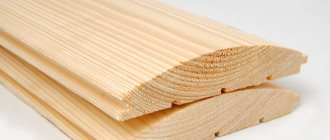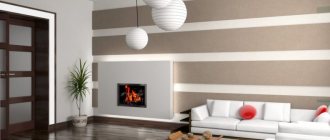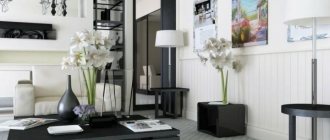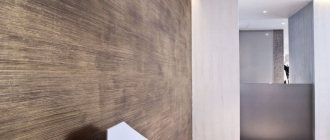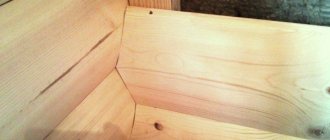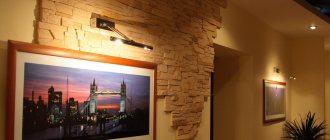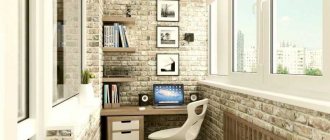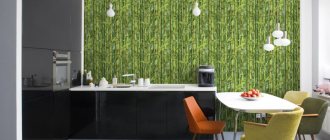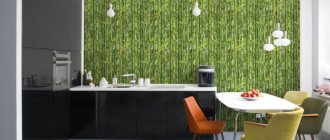What to paint with?
Wood is an aesthetically attractive material, but susceptible to various influences.
It can be damaged by moisture, temperature changes in winter, ultraviolet rays and insects. Block house elements made from natural raw materials are no exception. Impregnations and protective paint coatings will help extend the service life of a wooden facade. A more expensive version of the block house undergoes industrial processing in autoclaves. The coating elements are impregnated with compounds that protect the wood from fire, rotting and the destructive effects of other factors. Those who bought untreated parts should improve their properties themselves. This must be done before installation. It is advisable to process both the planks, the sheathing, and the base. Impregnations and stains are suitable for this.
Impregnations do not change the appearance of wood. All compositions can be divided into three groups:
- Acrylic water soluble ones are used for untreated wood. Good for interior decoration, as they do not have an unpleasant odor.
- Alkyd ones are made on the basis of white spirit and alkyd resins. They create a durable coating, but have a serious drawback - a pungent odor. Used only for facade work.
- Oilseeds are made from natural oils, most often linseed. The coating takes a long time to absorb and dry, but is durable. But it is incompatible with some paints.
Stains change the shade of wood towards darker tones. At the same time, they do not form a smooth layer or film on the surface. There are also colorless ones; they perform only protective functions. Compositions are produced on a water basis, as well as on the basis of alcohol, solvents and wax.
Decorative coating can emphasize the natural structure of the tree or change it in accordance with the owners' plans. In the first case, you should choose a transparent varnish or azure. If the surface of the parts is imperfect, paint will help hide some imperfections.
For decorative finishing of a block house, you can use materials, taking into account their characteristics.
Varnishes create a transparent or translucent film on the surface. Azures have the protective properties of impregnations and at the same time create a thin waterproof layer on the surface. They come in glossy and matte, transparent and tinted. Alkyd-urethane glazes make wood more resistant to mechanical damage. Paints - glossy, matte and semi-matte. For exterior finishing, it is better to choose oil rather than water-based finish. Wax – traditional finish with a matte sheen
It is important to remember that you can no longer apply varnish or paint on top of it.
Before painting the wall of a house covered with a block house, it is cleaned of dust or old coating. It is advisable to paint new parts before installation. Before applying paint, the wood is treated with a primer. It will improve the adhesion of the enamel to the surface. To work over a large area, craftsmen advise using a roller and painting hard-to-reach areas with a brush.
Varieties
A block house can be made of metal and wood. Let us examine in more detail what characteristics these types of finishing materials have.
Wooden
First, it’s worth considering what is good about cladding a house with wooden coverings:
- Such materials have a natural and expensive design. Buildings decorated in this way look cozy and welcoming.
- A wooden block house is an environmentally friendly material. It contains no dangerous chemical compounds. Even at high temperatures, such cladding will not emit harmful substances.
- A block house made of wood is a wear-resistant material. It is not easy to damage or break. He is not afraid of shocks and mechanical damage.
- High-quality panels are not susceptible to mold and mildew.
- The block house boasts excellent sound and waterproofing characteristics. In addition, such material will retain heat inside the house.
- Installation of wooden panels is simple and affordable. Even an inexperienced home craftsman can handle it.
The main disadvantage of a wooden block house is that it must be regularly treated with antiseptic agents. If such measures are neglected, such material may rot, lose its brightness of color and become a haven for wood parasites.
In addition, many consumers include its high cost as a number of disadvantages of a wooden block house.
For interior finishing, thinner lamellas with a thickness of 20-24 mm are used. Such coatings can only be used as decorative design elements. They are perfect for interior decoration because they are thin and do not take up excess space.
The block house is made from various types of wood and is divided into several classes.
- "Extra". Such finishing materials are of the highest quality. They have a pleasant smooth surface without the slightest defect. A block house like this is expensive because it undergoes complex processing.
- "A". Materials of this class may have small knots, minor mechanical damage, and darkened areas on their surface. In some places such a board may be uneven.
- "IN". A class block house may have cracks, knots and other noticeable defects.
- "WITH". Products of this class often have serious damage, noticeable cracks and knots.
Metal
Now it’s worth familiarizing yourself with the positive characteristics of a metal block house:
- this material is not subject to deformation even when exposed to low and high temperatures (from -50 to +80 degrees);
- metal block house is a durable material. It can last more than 50 years;
- such material is not afraid of sunlight and precipitation;
- metal block house is an environmentally friendly and safe material;
- it is not flammable;
- its installation is also considered quite simple;
- such finishing material does not need to be regularly maintained using expensive products;
- a metal block house can be laid on foundations consisting of any materials, but most often the floors of the house or the pediment are sheathed with this material;
- Such panels are inexpensive, especially when compared with natural wood coverings.
The only and main disadvantage of a metal block house is its impressive weight. That is why you can purchase such material only if the walls of the house are strong enough and reliable. There is a lightweight alternative to this material - an aluminum block house. However, it is less durable. It can be easily dented and damaged.
Options for wall decoration in a wooden house
There are many options for finishing a wooden house. It all depends on the operating conditions, finances, your desires and the style of the room.
Clean log house finished with paints and varnishes
If you strive for naturalness and environmental friendliness, and live in a region with a consistently dry and stable climate, then a log house made of natural wood is suitable for you.
In such a house you will always be haunted by the aroma of natural wood.
This type of finishing is increasingly gaining popularity among our stars. This original Russian style makes the room lively and the microclimate healthy. This type of finishing attracts with its beauty, durability, environmental friendliness, simple design and simplicity. Such projects can be recreated with historical accuracy in the way houses were built many centuries ago.
Lining as a wood finish for walls when it is impossible to sand the timber
Lining is a traditional material for home decoration. Its advantages are obvious - it is easy to install and looks quite aesthetically pleasing. The lamellas, with the help of special fasteners, are connected tightly.
Cladding with clapboard creates a perfectly smooth and beautiful surface
Other advantages of this material include:
- speed of installation;
- environmental friendliness;
- many shades of coating;
- made from different types of wood.
Among the disadvantages are:
- high price;
- the need to construct sheathing;
- the need for careful care.
Preparatory steps include not only the installation of the sheathing, but also the processing and inspection of the lamellas themselves
It is important to sand and dry them first.
The final stage is coating the lining with varnish, sanding and another varnishing.
Block house is a more modern type of lining. Typically, such blocks are made from high quality wood, which does not shrink, is not inferior in strength and strength, and in many ways even surpasses classical materials.
The block house allows you to maintain the unique microclimate of the roomIn addition, this finishing material does not lose its original quality due to wood processing. The texture of the material is no different from natural wood.
The main advantages of a block house:
- mechanical strength;
- environmental friendliness;
- aesthetic appearance;
- light weight;
- ease of assembly.
For interior decoration, slats with a thickness of no more than 25 mm are better suited. As the thickness increases, difficulties may arise with high-quality fastening of the sheathing. In addition, this can lead to a reduction in the internal space of the room, which is extremely undesirable. The disadvantages of the material include too low vapor permeability and increased flammability.
If you purchase material in winter, it is important to place it in a warm room to dry it
Finishing a wooden house inside with plasterboard
Drywall is the ideal solution for those cases when you need to hide or hide something. This could be some kind of communications, or planning defects. Typically, drywall is used to level walls. Most often, in a wooden house, plasterboard is used to finish ceilings or erect interior partitions. In addition, such coatings will be a good solution for bathrooms.
Drywall with a moisture-resistant coating can protect your bathtub walls from excess moisture
In addition, plasterboard is made in a fire-resistant version. This is exactly the case when it can be used to cover fireplaces or stoves, additionally protecting wooden walls from overheating and fire.
For wooden houses, timber sheathing is used as a base for drywall
Wall panels of various types
Wall panels for finishing a wooden house are quite a popular option. The choice of materials is quite large. The finish with natural veneer, as well as with laminated MDF, which is not afraid of moisture and can replicate almost any texture, looks very interesting.
MDF boards can imitate patterns not only of wood, but also of leather, bamboo, and plaster
What are the benefits of wall panels:
- simple and easy installation;
- good heat and sound insulation;
- stylish appearance.
The panels are also convenient because they can be selected to suit any size. They are also attached to the sheathing and have a tongue and groove fastening system. Externally, the seams are almost invisible. The coating looks like a single monolith.
Decoration with MDF boards can be selected to suit any interior
Related article:
What is used as raw material
Practice shows that false beams look very different in the interior. This is because it is made from different types of trees. Each has its own texture, its own color, its own pattern. This must be taken into account when purchasing material.
Light false beams make the room visually more spaciousSource ttrofimov.ru
If the bars are made from pine, they will be light yellow in color. Over time it will darken a little, but its golden shine will remain. Designers recommend choosing this material for wall decoration in the kitchen and hallway. Pine looks good in the decoration of the attic. There, its light shades help to visually expand the space and fill it with air.
Imitation of pine timber in the bedroom interiorSource pilomaterial-stroi.ru
In the interior, bars made of cedar always look royally luxurious. They are used to decorate living rooms, offices, and large reading rooms. This wood has a unique pattern, very beautiful and embossed, it adds restraint to any design.
After processing, the tree drawing is completely preservedSource fcld.access.ly
Therefore, when it is necessary to emphasize the severity of the chosen style, preference is given to wooden finishes made of cedar. It has its own smell, cedar is known for its healing properties, so interiors with cedar cladding have a beneficial effect on human health.
Cedar in the living room interiorSource glenoakspathology.com
Larch is a material that perfectly resists moisture. Under its influence, it swells slowly, so wooden trim made from larch is suitable for decorating kitchens, baths, saunas, and saunas.
False beams in sauna decorationSource stroyservis-74.ru
It has a light yellow tint. It makes small rooms visually larger, which is very important in the case of finishing the same steam room. The most common deciduous species are linden, alder and maple. The last two have pronounced tree rings. This material fits well into bedroom interiors. But its bright texture requires special attention to detail. If the choice falls on it, you will have to select everything (textiles, furniture, decor) in such a way that it fits perfectly into the overall design concept.
Imitation of larch timber in bedroom decorationSource archmasters.ru
Decorative bars in the interior, made of oak, immediately catch the eye, they always look expensive, and all because they have a unique texture. Imitation of oak timber will elevate any room, it will give it a special appearance, but you will have to pay a lot for such finishing.
Imitation of oak timber is luxurious and always stylishSource vash-artdom.ru
As you can see, any wooden finish significantly improves the interior; imitation timber is widely used. Sometimes even ceilings are sheathed with it. Look at the photo, the example shown shows how beautiful such a solution can look. Thanks to its pristine nature, wood ennobles a space, makes it warm, cozy, creates comfort that attracts a person and allows him to relax and unwind.
Wooden finishing ennobles the spaceSource 1povagonke.ru
What other finishing material can compete with wood in this? It's difficult to answer this question. Contemporary finishes make the living space appear discreet. She emphasizes rigor, and clear lines and angles help to do this. The rounded part of the beam softens the sustained severity.
Imitation timber is also actively used for facade finishing. Source dysecal.bapelonu.ru.net
The facade, finished with false timber, looks very naturalSource infokanal55.ru
Installation of sheathing
Assembling the puzzle inside the house begins with a frame made of beams. Both the primer for plaster and the blockhouse require preliminary installation in the form of lathing, otherwise the final result may be distorted over time. It is unlikely that anyone will want to live in a kingdom of crooked walls.
Detailed blockhouse installation diagram
This manipulation during installation often involves attaching beams with a diameter of 0.20 - 0.30 cm to the base. One of the simplest methods of fixation is universal self-tapping screws; nails can also be useful.
- Horizontal or vertical? When the house block is in a horizontal position, the sheathing bars are attached vertically, and vice versa. If necessary, the board must be adjusted to the required thickness. If you don’t have woodworking skills, you can put something under it (to make it bigger). Careful preparation of the sheathing will give you the opportunity to get a perfectly smooth wall.
- The saving level will control surface differences of 5 plus.
- Between the boards there are special compounds to retain the heat of the vapor barrier.
Blockhouse installation technology
Method of using a blockhouse from the inside
When installing panels in a source house from the inside of a building, it is necessary to install them on slats with a width of at least 30 millimeters, so it is possible to assemble panels on almost all kinds of walls, and it does not matter what kind of wall covering you have.
If you want to insulate the inner walls, you can do this by slipping the material under the panels during the paneling process. But in this case, the layer of slats must be larger.
In the main situation, the block house is located in a horizontal state for the purpose of interior decoration, but in certain cases a vertical system is also used, for example, in baths or steam rooms, this is necessary so that moisture does not accumulate in the grooves, but flows down.
Material selection
Decorative finishing should begin with the selection of materials. The block house is divided into several types depending on the type of wood and class of material.
Wood type
Block house slats can be made from several types of wood, differing from each other in texture, color, technical properties and cost.
The table shows the comparative hardness of some types of wood used for interior decoration.
Use coniferous wood for residential premises
For residential premises - living rooms and bedrooms, it is recommended to use coniferous wood. The subtle pine smell that will emanate from the walls and ceilings will have a calming effect on the nervous system of the inhabitants of the house.
In addition, the resin of coniferous trees has antiseptic properties, preventing the development of pathogenic bacteria in the room.
For cladding interior spaces with high heating temperatures (saunas, baths), it is recommended to use deciduous wood, since coniferous wood varieties tend to release excess resin when heated.
For finishing a bath, it would be optimal to use larch
You should also take into account such a factor as high humidity, so decorating the walls of a block house in such rooms involves the use of wood that is resistant to dampness.
At the same time, an important criterion for choosing the type of wood is personal preference. After all, the main purpose of decorating a wall with a block house is to create an interior that is pleasing to the eye, so if you like the openwork texture of Karelian birch or beech, purchase just such a material.
Panel size
Use thin panels to decorate rooms
When choosing panels, you should also pay attention to their size. Typically, the width of the lamellas ranges from 80 to 230 mm, but there may be exceptions to these rules
Wider panels are used to decorate the facades of buildings, since inside the house they will look too massive, creating an oppressive feeling and “eating up” the space.
As practice shows, for interior decoration it is better to take thin lamellas, 8–16 cm wide. The thickness of the lamella can be from 20 to 50 mm. The length of the block house slats can vary from 2 to 6 m, so when choosing a material, this parameter should also be taken into account so that there is as little production waste as possible.
Material class
Extra-class materials have a high price
In addition to the type of wood and size, the block house is also divided into classes depending on its quality.
It has enhanced decorative qualities; first of all, it is characterized by the almost complete absence of knots and other cosmetic defects. However, the cost of such a block house is quite high.
The next class of material is “A” and “B”. They have a larger number of knots, and some other defects are acceptable on their surface.
The cost of such material, accordingly, is significantly lower than that of the extra class, but if you are not too demanding of quality, then you should pay attention to this economy class option. Moreover, repairing small chips or dents is not difficult
What is a blockhouse
Blockhouse is a wall finishing material that is attached to the walls in the same way as lining. A wall lined with a blockhouse looks like a wooden frame made of logs or timber. Initially, this material was intended for exterior decoration. But recently it has increasingly begun to be used for interior decoration of premises for any purpose.
There are three types of blockhouse. It comes in wood, vinyl and metal. Each of these finishing material options imitate wooden beams or logs, but their performance characteristics are different. A metal blockhouse is a good modern material for exterior decoration. But it is not used for interior work.
Metal block house for exterior decoration
Wooden blockhouse
It is made from high-quality wood and has decent performance characteristics. Finished panels have high resistance to humidity, temperature changes, direct sunlight and mechanical stress.
The wooden house block is made from oak, larch, aspen, ash, cedar, and pine. In width it can be narrow (140 by 270 mm) and wide (190 by 45 mm). These are average sizes; they may vary slightly among different manufacturers. The length of the panels can be from 2 to 6 meters.
By quality, this material is divided into 3 grades - “Extra”, A, B and C. The highest quality products do not have any flaws and are produced under the “Extra” brand. The interior cladding of a house block is made primarily from this type of panel. The lowest grade is C.
Extra class block house On our website you can find contacts of construction companies that offer house design services. You can communicate directly with representatives by visiting the “Low-Rise Country” exhibition of houses.
Vinyl blockhouse
A vinyl blockhouse looks similar to a wooden one, but is made using PVC. Vinyl panels consist of two layers. The front layer provides the finish with aesthetics and protection from external influences. The second layer is needed to give the panels strength
When purchasing such material, you need to pay attention to the color of the outer and back layers. High-quality panels are the same color on both sides
Vinyl blockhouse has higher performance characteristics. But it is not an environmentally friendly material like wood panels. Therefore, for interior decoration it is used mainly in rooms with high humidity or in unheated areas. The interior decoration of a block house is mainly wood trim.
Vinyl block house under timber
Basement siding
Basement siding is used to finish a building in the base area. This cladding is made to protect the lower part of the house from the aggressive effects of precipitation and constantly operating mechanical factors.
Finishing the base with siding
To eliminate their harmful effects, cladding should be used, the thickness of which should exceed 3 millimeters. To solve such problems, installation of basement siding is used.
Basement siding
Individual elements of the building material have a relatively large thickness and are made in small sizes in order to ensure reliable fastening and reduce the likelihood of spontaneous destruction of the structure due to its large weight, which does not correspond to the fastening method used.
Attaching basement siding
To give a house a presentable appearance, they often use basement siding, which will not only provide reliable protection for the lower part of the building, but will also play an effective decorative role.
Basement siding also plays a decorative role
In accordance with the requirements of the owner of the building, you can select elements of basement siding that imitate various materials: wood, brick, stone. To ensure an affordable level of cost of building materials intended for the construction of a basement structure, manufacturers often combine it with affordable raw materials.
Basement siding imitating brick
In some cases, cement siding is used to cover the lower part of the building. It should be taken into account that in order to perform the functions assigned to the structure, its height should not be lower than 15 centimeters from ground level.
Finishing the base with cement siding
The advantages of basement siding lie in the possibility of its long-term use, the period of which practically corresponds to the life of a residential building, during which it will not be necessary to carry out work to eliminate damage caused by mechanical force or natural adverse factors.
In a house whose cladding is made in the style of basement siding, rodents cannot appear, due to the reliable protection of all walls from the possible entry of uninvited guests. The construction material does not crack and maintains a respectable appearance for a long period of time.
Basement siding has a long service life
When purchasing siding elements made from various materials, you should consider:
- thickness of the structural element;
- presence of defects on the surface;
- availability of certificates of product compliance with regulatory requirements;
- manufacturer's warranty.
In general, buyers prefer to equip their homes with cladding made from natural materials, due to their environmental friendliness and hypoallergenicity.
Types of basement siding
When choosing elements for a future structure, materials whose appearance imitates natural wood or stones are popular. Wooden siding is less popular in building cladding due to its high price and short-lived product life.
Basement wood siding
All types of siding can be easily washed when dirty. For convenience, a garden hose is used for such purposes, under the pressure of water from which any dirt can be easily removed with a sponge.
Siding needs regular washing and cleaning.
General information
Material characteristics
Block house is a natural material for wall decoration, therefore it has the appropriate characteristics:
- environmental friendliness - the material does not emit toxic substances; during manufacturing, the wood is dried under natural conditions without treatment with chemicals;
- heat preservation - panels maintain optimal temperature in the rooms;
- sound insulation - the material does not allow noise and annoying sounds from the street to pass through;
- ease of installation - due to the design of the elements, installation difficulties do not arise;
- light weight - lightweight panels are used to decorate the walls of balconies and loggias;
- aesthetics - attractive appearance makes the material very attractive to designers;
- Possibility of combination with other materials.
The material is not without its drawbacks:
- low level of fire safety - the panels are treated with fire retardants after installation in order to protect the home from troubles;
- change in shape - if the fastening rules are not followed, damage in the form of indentations remains on the lamellas;
- does not allow steam to pass through well - fungus and mold develop under the elements. In order to prevent undesirable phenomena, install a high-quality ventilation system and arrange ventilation.
Types of block houses for interior decoration
Block house varieties:
- exclusive material - elements that are smooth, without the slightest flaw, and have no noticeable defects. Used for decorating walls in expensive private homes;
- grade A - high-quality material for interior cladding of residential or commercial premises;
- grade B - small knots and irregularities are allowed. The material is used for finishing saunas and baths;
- grade C is an unremarkable material that is suitable for cladding commercial premises.
Combined types AB or BC are available on the market. Before purchasing a block house, experts advise making sure that the material was stored in compliance with all standards. Poor quality panels can crack and become deformed.
Rules for choosing a block house
Before purchasing the material, determine the location that is supposed to be finished with panels. Decorative elements are suitable for interior lining.
The bathhouse or dressing room is finished with panels made of aspen, alder and linden, avoiding conifers. This is explained by the fact that resin is released from the needles at high temperatures, and the tree also has a high heat capacity. The panels get hot, and this is not very convenient.
Application options
Block house cladding is carried out in two versions:
- full - finishing the walls and ceiling;
- combined - decorate one or more walls.
The block house is combined with other finishing materials, for example, wallpaper, lining, plaster, natural or artificial stone, forged metal products, glass. Panels make it possible to turn bold ideas and original solutions into reality.
If you want to restore the style of merchant houses or a simple rural house in your house, a block house is ideal. The material is often used to create houses in the style of alpine chalets. The panels are suitable for covering the walls of bedrooms, children's rooms, and living rooms.
Covering a bathhouse with siding
Siding - decorative panels of a standard size: width - 22 cm, length - 125 cm. The material can be metal or vinyl, has more than 10 colors.
To cover a bathhouse made of timber with siding, you must first install a profile frame or wooden sheathing on self-tapping screws. All installation work can be done independently. The surface of the walls is carefully treated with antiseptic compounds to prevent the formation of mold and harmful microorganisms.
The siding is installed in a horizontal position with a distance of 20 cm from the foundation of the building.
Covering a bathhouse with siding has the following advantages:
- protection of the facade from precipitation;
- resistance to temperature changes and fading;
- inertness to deformation and mechanical damage;
- Fire safety;
- absence of toxic elements;
- good air permeability;
- low level of moisture absorption;
- accessibility of installation.
However, the material has some disadvantages:
- high cost of individual fixing elements of the structure;
- the appearance of deformations and play due to violation of installation technology;
- the need to create a flat surface for fixing the panels.
Useful tips from the pros
As already mentioned, the methods of fixing the block house may vary - it can be attached to clamps, metal brackets or self-tapping screws. The main thing is that all metal elements have an anti-corrosion coating.
It is permissible to use isospan or its analogues as a vapor barrier. Mineral wool or penofol can act as insulation. It is better to avoid using polystyrene foam insulation.
If you want to decorate the interior surface with wood, using a block house made of wood is not the only option. Today, vinyl and polymer materials are produced that closely imitate a wooden beam or log.
See below for more details.
Self-finishing technology
Specialists are hired to decorate the house, but to save money you can do it yourself. When covering a room with a block house yourself, you must follow the following rules:
- Before starting installation work, wooden boards must be left in the room for several days. This is done to reduce the moisture content of the material.
- The board must be fastened along the guides.
- When attaching panels, they should be installed so that the tenon is on top and the groove is on the bottom. This installation allows you to minimize the entry of dust or dirt into the grooves.
- When installing, you need to leave a small gap between the floor and ceiling, which will serve as natural ventilation.
- The panels should also have a small gap between them. If moisture enters or temperature changes, this arrangement will prevent deformation of the material.
- Galvanized materials should be used as fasteners to avoid rust stains.
Preparing the block house
Before installing a block house in any part of the house, you need to wait some time so that the new beams go through the process of adaptation to the climatic conditions in which they will be located. The tree's susceptibility to natural decomposition makes it a good breeding ground for many insects and various forms of microflora. An important stage of preparation is the impregnation of wooden elements with antiseptic agents, which can significantly increase the resistance of wood to biological damage. Treating wood with a fire retardant increases the material's resistance to fire and mold.
Assembling or installing the frame
The complete assembly of the frame can be divided into five stages. During installation, some of the listed steps can be skipped in cases where there is no need for additional insulation of the room. Let's look at the installation steps:
- A vapor barrier material is attached horizontally to the wall. To fix it, you can use nails, but it is more convenient to use a construction stapler.
- Sheathing bars are attached on top of the waterproofing. It is also recommended to install the first layer of sheathing in a horizontal position.
- Thermal insulation material is installed in the cells of the sheathing.
- After the insulation, the waterproofing layer is installed again.
- At the last stage, the second layer of sheathing is fixed, which is now in a vertical position.
When installing, be sure to fix it level, since the block house will be installed on it.
Installation
The panels are mounted from the bottom corner in a horizontal position, along a pre-assembled sheathing. To fix the board, gluers are used; they are attached with self-tapping screws to the frame. A sheathing panel, which is positioned with the groove down, is inserted into the fastener tabs. The next board is placed with a groove on the tenon of the bottom panel. This procedure is repeated until the entire wall is finished.
If you refuse to use gluers and use self-tapping screws as fasteners, installation begins with preparing the seats for them. The fastening step is approximately 40 cm, and the self-tapping screw is screwed into the tenon with an inclination of 45 degrees. To give an aesthetic appearance, the fastening material is masked.
Finishing the corners is the most difficult. At this stage, when carrying out work, special elements are used to design internal and external corners. However, they do not always allow you to completely hide all the cracks, so for masking they use planed timber, which is attached before the sheathing begins. This design allows you to fix the boards of the block house directly to the timber and gives the cladding an aesthetic appearance.
Decoration methods
To give the surface of a block house improved properties and the required color shade, special impregnations that contain pigments and oils are used. Acrylic, alkyd, oil – these are the bases used for painting materials. Glazing paints, absorbing into the wood, cover it with a uniform layer and do not create smudges. They enhance the natural beauty of the patterns. Painted timber stands out noticeably against the background of untreated boards.
In addition to glazing compounds and various impregnations, wood paints are used. They are made on a water basis. Organic and synthetic solvents are also used. Paints have their drawbacks that should be considered when using them inside the home. They hide the natural structure of the wood and emit an unpleasant odor. To paint timber, colored and clear varnishes and stains with a rich range of shades are also used.
Carrying out installation work
The first step is to assess the surface on which installation will be carried out. It is important to identify all the irregularities that will be taken into account later. To carry out this operation, you will need a long rule, which must be placed at various points on the wall. The sheathing is being installed. To do this you will need a hammer drill, screws and dowels. All unevenness of the wall can be easily compensated by cutting the boards with a plane or placing supports. The most difficult part is attaching the first two sheathing boards. They are fixed at the edges of the wall and must be at the same level. You can use a laser level for this.
Several threads are stretched between the two exposed slats and the remaining slats are installed along them. It is necessary to place vertical planks every 50 cm. They must be vertical, since the house itself will be mounted horizontally. If additional sound insulation or insulation is required, then the required material is placed under the block house between the sheathing posts. It is easier to install a house from the bottom up. The first plank is leveled with the groove up and secured with a self-tapping screw at an angle. In this way, the set is made to the very top. If during measurements it becomes clear that the last plank of the block house needs to be cut by more than half, then it is better to reduce the width of the first and last plank equally.
It happens that the length of one house plank is not enough for the wall, then they are connected with a special element that covers the joint. A rather difficult step is processing the corners of the block house. If this is an external corner that is sewn up with a block house, then all the strips of material can be cut at 45° and they are joined with the inside of the block house strip. For these purposes, you can use a special corner element, which simplifies the task. Internal corners can also be covered with additional trim or pattern fitting for a seamless fit. Ventilation gaps of 1 cm are made from the floor and ceiling. They can be covered with baseboards. A video about the installation of the block house can be seen below.
Block house is an excellent material that is suitable for interior decoration and adding comfort to the room. The installation of a block house can be done carefully the first time, if you do not rush. It is better to take measurements several times and only then cut or secure the block house strip. After installation, you can carry out final cleaning using a sanding machine before applying varnish.
- Liquid glass and its application
- How many boards in a cube
- Fiberboard or hardboard
- DIY bark beetle plaster
For which houses is a wooden block house suitable?
A wooden block house can be used on all houses without exception. The paneling creates the effect of a hut or tower; rural design motifs are used. The finishing style corresponds to centuries-old traditions.
There are no contraindications to installing the material; there are only normal technological requirements. If external insulation is used, then, depending on its type, it may be necessary to create a ventilation gap (for vapor-permeable materials such as mineral wool) or its absence (for impermeable types such as polystyrene foam, polystyrene foam or EPS).
A wooden block house requires periodic maintenance - applying a layer of varnish or painting. This need is due to the inherent qualities of the material and has nothing to do with the construction of the house. Periodically applying a coat of paint has a positive effect - the appearance of the house is updated, the cladding is refreshed, becomes brighter and newer.
Under the timber
The timber block house has a more austere and collected look. A canvas made of such material looks like a wall made of high-quality planed timber, although structurally it can consist of any material.
The walls look smoother, the presence of planes makes the canvas neater. The style of the house and the manner of decorating the facade are more urban and tend to use architectural decorations
A block house built under timber creates a more modern look for the house than when using panels made under logs. The walls look smoother, the presence of planes makes the canvas neater. The style of the house and the manner of decorating the facade are more urban and tend to use architectural decorations.
Metal
A metal block house is a type of metal siding with a panel profile designed to look like timber or logs (for example, golden oak). The similarity to traditional wood panels is purely external. The technical characteristics and performance qualities of the material are typical for galvanized steel siding.
The metal block house has high strength and is resistant to external loads. At the same time, it has low sound insulation, which is noticeable when it rains. Installation of the material is quite simple and does not require special preparation; the only condition is the creation of temperature gaps and loose fastening of the material to the support system, which allows movement during expansion from heating.
A significant difference between a metal block house is the absence of the need to maintain the canvas. The material is manufactured in different modifications and has a wide selection of colors. The kit includes all the necessary components created for the design of corners, openings, junctions and other elements of the facade.
Vinyl
A vinyl block house, like a metal one, has only a decorative resemblance to a wooden prototype and has its own qualities and characteristics. The material is very elastic, which allows it to respond painlessly to small mechanical loads. Absolutely not susceptible to corrosion, exposure to water, and frost-resistant. At subzero temperatures it becomes more brittle and can crack under mechanical stress.
When installing, you should follow the same rules as for metal siding - creating temperature gaps and loose fastening of parts to the subsystem. The peculiarity of the vinyl block house is the low weight of the panels, which makes it possible to use it on any home without exception.
Advantages and disadvantages
Lining has its advantages and disadvantages. First of all, let's look at the main advantages of the material:
- Environmental friendliness. Since wood is used as the basis for manufacturing, the panels are completely natural, do not emit harmful substances and do not cause allergic reactions.
- Strength. Panels designed for outdoor use can withstand external factors: hail, sand, rain, sunlight. A block house made of hardwood is resistant to rot and can be used in conditions of high humidity. Due to the natural resin content in the wood structure, additional waterproofing is created.
- Aesthetics. Wood products look beautiful due to their natural appearance; such panels can decorate the interior of a room or give the house an original look if used as exterior cladding. The lining does not need to be decorated additionally – it is enough to just cover it with a protective compound. Although, if necessary, the panels can be easily painted in any desired color.
- Easy installation. The block house turns out to be quite light, so it is convenient to work with it; you can do it on your own, without involving a team of builders or using special equipment. In addition, the boards do not create additional load on the foundation of the house.
- Heat retention. Wood has good thermal insulation properties, so the paneling acts as an additional insulating layer.
The disadvantages of the material include low vapor permeability: condensation may occur between the sheathing and the wall. Reviews say that this can be avoided if you take care of a good ventilation system during construction and renovation. Another disadvantage is the flammability of wood. To protect your home, you need to use special protective impregnations designed for processing lumber.
Vinyl block house is an imitation of lumber. It costs more because it has a number of advantages:
- Reduced weight. Such panels are 10–15 times lighter than wood, which reduces the load on the walls and foundation, and also facilitates the construction or repair process.
- Fire safety. The material does not burn, so even if a spark hits there is no risk of flame spreading. Can be used in rooms with fireplaces.
- Sustainability. Withstands temperature changes in the range from -50 to +50 degrees. Does not fade when exposed to direct sunlight. It will last about 50 years, which is longer than the service life of lumber.
The disadvantages of the products are mainly related to installation work. They require a certain technology: you need to leave gaps, rigid fastening is not recommended. Vinyl panels are not very suitable if you plan to mount something on the walls in the future, for example, to hang shelves. These products do not have good load-bearing capacity, which can make it difficult to drive nails into the wall or fix other types of fasteners.
There is also a metal block house that looks like clapboard. It is a type of siding and is used for exterior cladding of buildings. It is made of durable galvanized steel, so the material has various advantages:
- withstands temperatures in the range from -50 to +80 degrees and can last more than 50 years;
- is not susceptible to atmospheric influences, therefore it is well suited for the role of street cladding of buildings;
- when installing additional thermal insulation, it will provide protection from frost, preventing the accumulated heat from quickly evaporating.
Despite all the advantages, metal products remain quite affordable: their cost is approximately equal to the price of lumber. The negative side is that the metal gets very hot in the sun, so the house will be hot. Also, additional elements will be required to assemble the coating.
Design solutions
A thin and light block house is suitable for covering both a city apartment and a country house. Moreover, the latter does not necessarily have to have a massive base; cladding a frame house is a fairly common practice in private housing construction. Moreover, there are many ideas for cladding.
It is not at all necessary to cover the entire room with a block house; it can be a specific area. The material goes well with stone, brick, and tiled surfaces.
The block house can be combined with other wooden textures (boards, lining), as well as delicate, noble textiles. This warm natural material combines harmoniously with forged and glass elements.
A block house is the best option for recreating the atmosphere of a house in the Russian style - an expensive merchant house or a more laconic, in some ways even ascetic peasant house. Interior styles such as chalets and the atmosphere of a small hunting lodge are also impossible without the use of wood.
Due to the environmental friendliness of the material, it can be used not only in the living room and hallway, but also in bedrooms, dining rooms and even children's rooms.
Covering an office with a block house will add rigor, respectability, and emphasize the status and good taste of its owner. It is better to choose a material of a darker shade, combining it with matching furniture, natural leather, and original design elements.
For living rooms and bedrooms it is better to choose lighter options; it is possible to combine several types of block houses with different textures
If panels for rounded logs are used, they will attract attention. In this case, furniture and accessories should have simple shapes and be quite discreet
When finishing a bathroom with a block house, it can be turned into a luxurious boudoir. Typically, light-colored material is also used here. As an option - bleached wood. For more aristocracy, you can add dark “logs”. When choosing this cladding option, you should carefully treat the wood with water-repellent compounds.
DIY
Due to the simplicity of the design of any type of gazebo, manual installation of this structure does not require significant effort or professional construction equipment.
To independently erect a small building, a minimum set of construction materials is required.
In addition to mechanical actions, it is necessary to perform pre-treatment of all wooden materials.
Each lath, wall board and especially frames in closed structures must be treated with a special antiseptic. This will limit the spread of fungus and rotting processes.
After the preparatory phase, you should begin assembling the main frame. The initial stage involves creating a solid foundation for the future recreation area.
If open buildings require the use of lightweight types of foundation, then closed brick buildings require a massive foundation.
